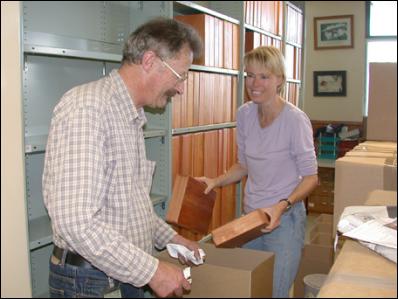Bugs and fungi make crucial journey
Bugs and fungi make crucial journey
Priceless collections comprising millions of invertebrates and thousands of fungi will be carefully transported across Auckland over Easter.For many years, Landcare Research's Mt Albert site has housed the country's most comprehensive collections of insects and fungi.

Photo: Getting the 'travel bug': Landcare Research's insect and fungal collections are being packed up and moved to a new site. Entomologists Des Helmore and Birgit Rhode are packing wooden boxes of pinned insects into cartons.
These scientific treasure troves provide means to identify individual species and their relatives, and authenticate the presence (or absence) of species for conservation and biosecurity purposes.
The collections are now being packed up for removal to improved conditions in Landcare Research's new 'green' building at Auckland University's Tamaki site.
The New Zealand Arthropod Collection (NZAC) contains 6.5 million specimens, from bees to beetles to butterflies - 90% from New Zealand, and the rest held on behalf of Pacific Island countries. NZAC curator Dr Trevor Crosby says staff have been working for three weeks solid to pack the collection.
"We've packed about 13,000 wooden boxes of pinned insects. We've also packed about 70,000 microscope slides of mounted specimens in such a way that slides won't move or break.
"Softer bodied invertebrates or larvae are stored in jars of ethanol. A professional packing firm has been wrapping the 9,000 jars and transferring them to plastic containers and pallets."Dr Crosby says at least two-thirds of the specimens will be transferred to Tamaki over the Easter break.
"We are trucking them over in small loads only, to spread the risk. Especially important are the 4,500 name-bearing primary type specimens held in trust for world science: these are irreplaceable.
"The journey is just 15 kilometres, but it is a huge undertaking. Logistically it is just as difficult as moving to another city."Dr Crosby says improved conditions at Tamaki will make it all worthwhile.”
The Tamaki conditions meet international standards. The pinned specimens will be stored horizontally in drawers, a safer long-term storage method than the current A4 sized boxes stored upright like library books. Also, ethanol specimens will be stored at a lower temperature, which will greatly help to preserve them." Fungi on the moveLandcare Research mycologists (fungal scientists) have also been hard at work, packing the more than 70,000 specimens contained in the New Zealand Fungal Herbarium.
"The storage cabinets, containing over 4,000 boxes of specimens, have been carefully dismantled and are being reassembled at the new site," says Dr Peter Buchanan.
"We will shift about half of the collection over Easter and will finish the job two weeks later." Dr Buchanan says the lower temperature and humidity in the Tamaki storage area will help reduce the risk of insect contamination of specimens.
"There will also be more space to accommodate growth.
"The herbarium is growing by about 2,000 specimens a year. All major groups are represented, with an emphasis on plant pathogens, other microfungi and wood decaying fungi."
Research's new energy-efficient Tamaki building will be officially opened on Thursday, April 29.


 University of Auckland: Protecting Young Minds With AI
University of Auckland: Protecting Young Minds With AI Greenpeace: Greenpeace Calls On Fonterra Investors To Consider Big Picture With Giant Puzzle
Greenpeace: Greenpeace Calls On Fonterra Investors To Consider Big Picture With Giant Puzzle Hugh Grant: How New Tech Helps Kids Love Soccer More
Hugh Grant: How New Tech Helps Kids Love Soccer More Bill Bennett: Download Weekly - 100% claim lands One New Zealand in criminal court action
Bill Bennett: Download Weekly - 100% claim lands One New Zealand in criminal court action FSCL: Woman Scammed Out Of $25,000 After Job Offer On LinkedIn
FSCL: Woman Scammed Out Of $25,000 After Job Offer On LinkedIn NIWA: Cheers To Crustaceans - New Species Named After Welly Brewery
NIWA: Cheers To Crustaceans - New Species Named After Welly Brewery



